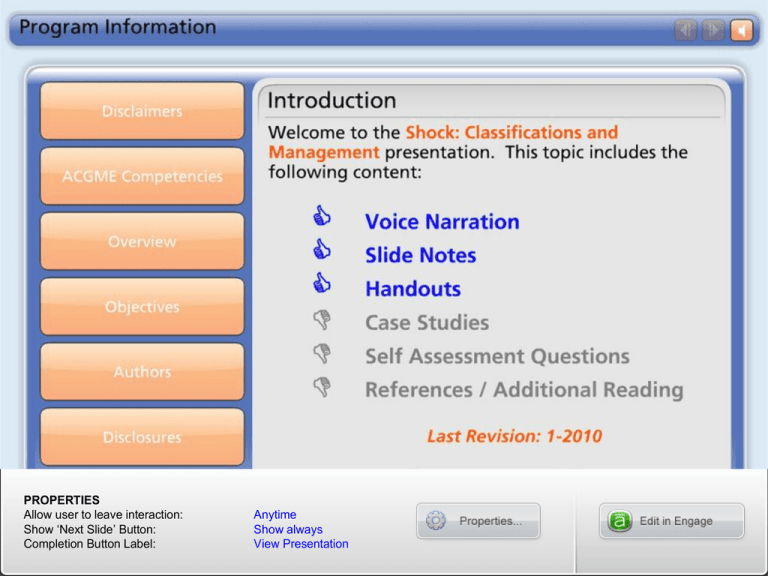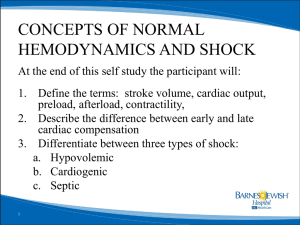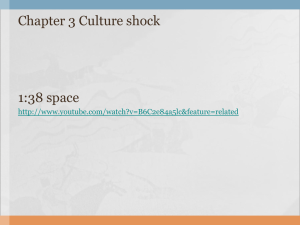Shock - Thomas Jefferson University
advertisement

PROPERTIES Allow user to leave interaction: Show ‘Next Slide’ Button: Completion Button Label: Anytime Show always View Presentation SHOCK Classification and Approach to Management Anand Kumar, MD Section of Critical Care Medicine Section of Infectious Diseases University of Manitoba, Winnipeg, Canada UMDNJ-Robert Wood Johnson Medical School Cooper Hospital, NJ Slide 2 Shock • Cardiogenic Shock -a major component of the mortality associated with cardiovascular disease • Hypovolemic Shock -the major contributor to early mortality from trauma • Septic Shock -most common cause of death in American ICUs Slide 3 Definition • Kumar and Parrillo (1995): “the state in which profound and widespread reduction of effective tissue perfusion leads first to reversible, and then if prolonged, to irreversible cellular injury” Slide 4 Shock: Classification • Hypovolemic Shock -due to decreased circulating blood volume • Cardiogenic Shock -due to cardiac pump failure related to loss of myocardial contractility/functional myocardium or structural/mechanical failure • Extra-cardiac Obstructive Shock -due to obstruction to flow in the cardiovascular circuit • Distributive Shock -caused by loss of vasomotor control Slide 5 Shock Hemodynamics CO SVR hypovolemic cardiogenic obstructive afterload preload distributive pre-resusc post-resusc Slide 6 PWP EDV Classification of Shock Hypovolemic Cardiogenic Extracardiac Obstructive (e.g. Hemorrhage) Distributive (e.g. septic) (e.g. Myocardial infarction) Diastolic filling Ventricular afterload (e.g. tension (e.g. massive pulmonary Preload Myocardial damage pneumothorax embolus) or pericardial tamponade) ( Diastolic Diastolic filling Systolic and diastolic filling) function Diastolic function Systolic function Preload CO = cardiac output; SVR = systemic vascular resistance; MAP = mean arterial blood pressure; MODS = multiple organ dysfunction syndrome. ( Systolic and Diastolic function) SVR ( CO) CO ( SVR) MAP Shock Kumar and Parrillo, 2001 Myocardial depression MODS Slide 7 Maldistribution of flow Hypovolemic Shock • degree of volume loss response – 10% well tolerated (tachycardia) – 20-25% failure of compensatory mechanisms (hypotension, orthostasis, decreased CO) – >40% loss associated with overt shock (marked hypotension, decreased CO, lactic acidemia) Slide 8 Hypovolemic Shock • rate of volume loss and pre-existing cardiac reserve response • acute 1 L blood loss results in mild to moderate hypotension with decreased CVP and PWP Slide 9 Cardiogenic Shock • #1 cause of in-hospital mortality from Q-wave MI • requires at least 40% loss of functional myocardium • usually involves left main or left anterior descending obstruction • historically, incidence of cardiogenic shock post-Q wave MI has run 8-20%with mortality 70-90% Slide 10 Cardiogenic Shock • mortality substantially better for cardiogenic shock due to surgically remediable lesions – aortic valve failure – papillary muscle rupture • ischemic form seen 3-7 days post-LAD territory infarct • v wave of > 10 mm often seen in PWP trace – VSD (post-infarct, rarely traumatic) • post-infarct seen 3-7 days post-LAD occlusion • 5-10% oxygen saturation step-up Slide 11 Obstructive Shock • rate of development of obstruction to blood flow response – acute, massive PE involving 2 or more lobar arteries and 40-50% pulmonary bed can cause shock – acute cardiac tamponade can occur with 150 mL fluid but over 2L can be well tolerated if slow accumulation • similar variability based on presence of pre-existing cardiopulmonary disease Slide 12 Distributive Shock • defining feature: loss of peripheral resistance • dominantly septic shock, anaphylactic and neurogenic shock less common • clinical form of shock with greatest contribution of other shock elements i.e., hypovolemia, cardiac failure Slide 13 Compensatory Responses to Shock • Maintain mean circulatory pressure • Volume – Fluid redistribution to vascular space – Decrease Renal losses • Pressure – Decreased venous capacitance Kumar and Parrillo, 2001 Slide 14 Compensatory Responses to Shock • Maximize cardiac performance • Increase contractility • Redistribute perfusion • Optimize oxygen unloading Kumar and Parrillo, 2001 Slide 15 hypovolemia intravascular volume sepsis myocardial dysfunction (e.g. MI) cardiovascular obstruction (e.g. massive PE) venous capacitance venous pressure cardiovascular stress renal perfusion circulatory shock ( MAP) stretch receptors baroreceptors right atrial aortic arch, carotid body pulmonary artery vascular chemoreceptors carotid, aorta medullary hormonal sympathetic response renal juxtaglomerular chemoreceptor epinepherine apparatus CNS pituitary response norepinephrine renin/angiotensin ACTH/ADH neural aldosterone cortisol cardiac contractility aldosterone Na/H2O retention vasoconstriction cardiac contractility Kumar and Parrillo, 2001 Na retention vasoconstriction flow redistribution maintain cardiovascular flow redistribution catecholamine Slide 16 responsiveness ORGAN SYSTEM DYSFUNCTION ORGAN SYSTEM MANIFESTATIONS CNS Encephalopathy (ischemic or septic) Cortical necrosis Heart Tachycardia, bradycardia Supraventricular tachycardia Ventricular ectopy Myocardial ischemia Myocardial depression Pulmonary Acute respiratory failure Adult respiratory distress syndrome (ARDS) Kidney Prerenal failure Acute tubular necrosis GI Ileus Erosive gastritis Pancreatitis Acalculous cholecystitis Colonic submucosal hemorrhage Transluminal translocation of acteria/endotoxin Kumar and Parrillo, 2001 Slide 17 Organ System Dysfunction ORGAN SYSTEM MANIFESTATIONS Liver Ischemic hepatitis “Shock” liver Intrahepatic cholestasis Hematologic Disseminated intravascular coagulation Dilutional thrombocytopenia Metabolic Hyperglycemia Glycogenolysis Gluconeogenesis Hypoglycemia (late) Hypertriglyceridemia Immune System Gut barrier function depression Cellular immune depression Humoral immune depression Kumar and Parrillo, 2001 Slide 18 Clinical Approach to Diagnosis and Management Shock Suspected • • • • • Hypotension Tachycardia Peripheral hypoperfusion Oliguria Encephalopathy Slide 19 Diagnosis and Evaluation • Clinical Signs – primary diagnosis – differential Dx Slide 20 Diagnosis and Evaluation • Laboratory – Hgb, WBC, platelets – PT/PTT – Electrolytes, arterial blood gases – BUN, Cr – Ca, Mg – serum lactate – ECG Slide 21 Clinical Approach to Diagnosis and Management • Initial Diagnostic Steps • CXR • abdominal views* • CT scan abdomen or chest* • echocardiogram* • pulmonary perfusion scan* Slide 22 Diagnosis and Evaluation • Invasive Monitoring – arterial pressure catheter – CVP monitoring – ScvO2 Slide 23 Clinical Approach to Diagnosis and Management • Admit to Intensive Care Unit (ICU) • Venous access • Central venous catheter • Arterial catheter • EKG monitoring • Pulse oximetry • Hemodynamic support (MAP <60 mmHg) Slide 24 Clinical Approach to Diagnosis and Management • Diagnosis Remains Undefined or Hemodynamic Status Requires Repeated Fluid Challenges of Vasopressors • Pulmonary Artery Catheterization • Echocardiography Slide 25 Diagnosis Using Pulmonary Artery Catheterization Diagnosis Cardiogenic Shock Pulmonary Artery Occlusion Pressure Cardiogenic shock due to myocardial dysfunction Cardiogenic shock due to a mechanical defect Acute VSD Cardiac Output Miscellaneous Comments Usually occurs with evidence of extensive myocardial infarction (40% of LV infarcted), severe cardiomyopathy, or myocarditis. LVCO and RVCO >LVCO Predominant shunt is left to right, pulmonary blood flow is greater than systemic blood flow: oxygen “step-up” occurs at RV level. Kumar and Parrillo, 2001 Slide 26 Diagnosis Using Pulmonary Artery Catheterization Diagnosis Cardiogenic Shock Pulmonary Artery Occlusion Pressure Acute mitral regurgitation Right ventricular Extracardiac obstructive forms of shock Pericardial tamponade Cardiac Output Forward CO Normal or or Slide 27 Kumar and Parrillo, 2001 Miscellaneous Comments V waves in pulmonary artery occlusion pressure tracing. Elevated RA and RV filling infarction pressures with low or normal pulmonary artery occlusion pressures. RA mean, RV enddiastolic, pulmonary artery occlusion mean pressures are elevated and within 5 mmHg of one another. Diagnosis Using Pulmonary Artery Catheterization Pulmonary Artery Diagnosis Occlusion Pressure Extracardiac obstructive forms of shock Massive pulmonary Normal or embolism Hypovolemic shock Distributive forms of shock Septic shock Anaphylactic shock Cardiac Output Miscellaneous Comments Usual finding is elevated right-sided pressures. or normal or normal Slide 28 Kumar and Parrillo, 2001 or normal, rarely or normal Pre-resuscitation cardiac output is decreased Clinical Approach to Diagnosis and Management Immediate Goals in Shock Hemodynamic support MAP >60mmHg PAOP = 12-18 mmHg Cardiac Index >2.2 L/min/m2 Maintain oxygen delivery Hemoglobin >9 g/dL Arterial saturation >92% Supplemental oxygen and mechanical ventilation Reversal of oxygen dysfunction Decreasing lactate (<2.2 mM/L) Maintain urine output Reverse encephalopathy Improving renal, liver function tests MAP = mean arterial pressure; PAOP = pulmonary artery occlusion pressure. Slide 29 Clinical Approach to Diagnosis and Management • Hypovolemic Shock • Rapid replacement of blood, colloid orcrystalloid • Identify source of blood or fluid loss Slide 30 Clinical Approach to Diagnosis and Management • Cardiogenic Shock • RV infarction – fluid and inotropes with PA catheter monitoring • Mechanical abnormality Slide 31 Results of Current Therapy Treatment Strategy In-hospital Mortality Rate (%) Inotropic support + Thrombolysis + IABP + CABG + PTCA if successful if unsuccessful 90 80-90 80 50-60 50-60 80-90 From Klein L. W.: Intra-aortic balloon pumping. In Parrillo J.E., Bone R.C. (eds), Critical Care Medicine: Principles of diagnosis and management, St. Louis, 1995: Mosby. Slide 32 Clinical Approach to Diagnosis and Management • Extracardiac Obstructive Shock • Pericardial tamponade Slide 33 Courtesy of David Hunter, MD University of Minnesota Slide 34 Clinical Approach to Diagnosis and Management • Distributive Shock • Septic shock - Identify site of infection and drain, if possible • Goals: – SV02 >70% – improving organ function – decreasing lactate levels Slide 35 Fluid Therapy • Crystalloids • Colloids • Packed red blood cells • Infuse to physiologic endpoints Slide 36 Relative Potency: Vasopressors/Inotropes Agent Dose CARDIAC PERIPHERAL VASCULAR Heart Contractility Vasoconstriction Vasodilation Dopaminergic Rate Dopamine 1-4 (m/k)/min 4-20 (mg/kg)/min 1+ 2+ 1+ 2-3+ 0 2-3+ 1+ 0 4+ 2+ Norepi 2-20 mg/min 1+ 2+ 4+ 0 0 Dobutamine 2-15 (mg/kg)/min 1-2+ 3-4+ 0 2+ 0 Isoproterenol 1-5 mg/min 4+ 4+ 0 4+ 0 Epinephrine 1-20 mg/min 4+ 4+ 4+ 3+ 0 Phenylephrine 20-200 mg/min 0 0 3+ 0 0 Vasopressin 0.01-0.04 u/min 0 0 4+ 0 0 Milrinone 37.5-75 mg/kg bolus; then 0.3750.75 ug/kg/min 1+ 3+ 0 2+ 0 Kumar and Parrillo, 2001 Slide 37 Conclusion • This concludes the presentation. Slide 38



![Electrical Safety[]](http://s2.studylib.net/store/data/005402709_1-78da758a33a77d446a45dc5dd76faacd-300x300.png)




